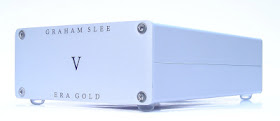
I first heard the
VPI HW-19 turntable way back in my early audiophiles day of 1990. It was a friend's setup using Quad ESL-63 speakers, a heavily modified and fully regulated McIntosh 240 amplifier and a regulated Dynaco PAS. The VPI sported an air bearing
Eminent Technology ET2 tonearm and a Sumiko Bluepoint. Up to that point my experiences with turntables was limited to my father's Garrard unit and the various 'mainstream' Japanese turntables that were popular at the time. So needless to say I was surprised how good records could sound. I never heard hall reverberation, vocal and instrument realism like that before. You have to remember that this was the heyday of CDs and everyone was ditching their vinyl collection so it seemed at odds against the stated supposed superiority of digital. Well VPI certainly changed my mind about digital and due to my college budget I ended up buying a used Thorens TD-165 table. I never got the great sound out of the Thorens that I heard on the VPI and at the time I attributed the differences to cartridges, preamps and my cheaper speakers. Back then I made the mistake thinking that the amplifier made the biggest difference in the signal chain.
As the years went by and CD sales grew larger and larger, I ended up slowly decreasing my record collection purchases. With CDs I could copy and rip down songs - plus my interest in new releases and re-issues limited my purchase of records. After my experiences with the Monica NOS and the transformer coupled
RAKK DAC I began to think that digital has finally been able to sound good enough to compete with a good turntable setup. And why bother with the fussiness of analog? Record cleaning, cartridge changing and 'table setup has certainly driven away the masses and me along with them.
I recently hooked my
UREI 813A loudspeakers back up to do some
amplifier testing. I've always liked the overall UREI sound but was disappointed in the higher frequency dryness - attributing any nastiness to the horn loaded compression tweeter. I was thinking of buying some Magnepan loudspeakers and continuing on my digital path until my fellow 'phile friend let me borrow his second vinyl rig. This is his setup that he uses for needledropping and consists of a glass platter Rega P2, Ortofon 2M Red and a simple phono stage that I built for him some 2 years ago. It is basically an ARC SP-3 type 12AX7 based circuit but with a much beefier choke based power supply.
I honestly wasn't expecting much from this setup when we hooked everything up. And I knew there was going to be some bass rolloff problems with the high impedance phono driving the 25k input load of the
Threshold FET-10/HL linestage. So we queued up our first record -
"Buddy Guy & Junior Wells - Drinkin' TNT 'n' Smokin' Dynamite" - and sat back to listen. Wow! I was taken aback by the smoothness and overall coherent sound of this setup. Sure, there were minor issues - but the musicality beat out my more expensive RAKK DAC on several levels. And oddly enough the irritating drynesss of the treble was gone!
After listening to a few more records I came to the conclusion that all along that the UREI 813As were telling me that many DACs have difficulties reproducing high frequencies. So I was blaming the speakers when instead they were just telling me the truth all along. Soundstaging, detail and body was better too. There was just something 'right' about the sound that made me enjoy music on a more emotional level. Looking back it seems that the RAKK really made me look at music objectively instead of enjoying the beauty and art.
So with that in mind I decided against buying the Magnepans and went for an analog upgrade instead. My vinyl-friend recommended a VPI - he is familiar with them since he runs a MKIV with the TNT platter upgrade and a SME 309 tonearm. So I cruised through Audiogon until I found a MKIII that looked good. This one sports a Rega RB300 and has been modified to have VTA on the fly. I also bought an Ortofon 2M blue and a Graham Slee Era Gold Mk V to round out the signal chain.
The older HW19 turntable are fairly unique for their floating plinth. The plinth supports the heavy platter and arm, but sits on top of four springs. This is meant to isolate the table from the motor. Many more modern designs seemed to have shied away from this approach - using a single heavy plinth to support everything. Though this reduces the construction cost, I would think that unless great care is taken there will still be more motor vibration issues.
How does the VPI sound compared to the Rega P2? Well I'm running a slightly different cartridge - but there seems to be more solidity and more of a foundation to the music. There is more inner detail and the overall sound is cleaner too. In comparison the Rega sounds a little gray and 'dirty' in the background. This is an effect of the less weighty platter and cheaper overall construction. However the Rega is still a good table and worth the trouble for a beginning setup.
I still have some cartride break in and VTA tweaking to do - so I'll report on the Ortofon 2M Blue and Graham Slee on a later posting. But for now I'm pleased with my purchase of the VPI - it has been a big upgrade to my enjoyment of music. I can't wait to start the upgrade process with better cartridges, a VPI SDS power supply, SAMA, tonearm upgrades, etc. This is certainly a fine way to drain my already economically damaged bank account!
.



